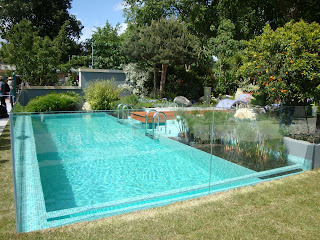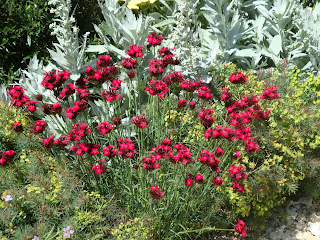Walking on sunshine
 |
| Autumn on Windermere |
Having dragged myself back to my blog after what seems like a long absence, I have no excuses for my tardy approach. I haven’t been double digging in the veg bed and no doubt sadly neglected a lot of tasks which should have been performed before the onset of winter. So no real excuses for not blogging.
I have been praying that the frost would stay away that bit longer, so that my happy flowering geraniums would flourish just a few more weeks. Oh and I have been to Highgrove. I have also been reading! To quote the ‘bad tempered gardener’ Anne Wareham, (she has a fab website – thinkingardens, http://thinkingardens.co.uk ) - there is a lot of ‘garden porn’ around. The mushy, cuddly, ‘I loved it’ type of article can be entertaining but it is not always helpful for someone who wants to know the how, where and why of aspects of gardening. Anyway, more of Anne later. So, I turned to two of my favourite garden designers for inspiration. Tom Stuart-Smith and Chris Beardshaw. Out with the garden porn and in with the practical and intelligent.
Tom, writing in The Telegraph, pondered the role of the subconscious in planting design. http://www.telegraph.co.uk/gardening/plants/8655319/What-role-does-the-subconscious-play-in-garden-design.html
This sounds like an excellent title for a Master’s thesis I thought - reading on I found the crux of the article was basically that we draw on a rich mixture of influence and memory when we devise some idea of how a garden might be planted. We should not be trying to compete with or outdo nature. Indeed, our gardening is often to do with pleasant memories and experiences – a pleasant walk through a wood, an idea from Chelsea or something we have seen on television.
Around about the same time as Tom’s article, Germaine Greer – also writing in The Telegraph, exhorted us to give up the struggle with weeds and pests.
http://www.telegraph.co.uk/gardening/gardeningadvice/8710995/Germaine-Greer-Let-nature-take-its-course-in-the-garden.html
Her opening comment was: “Is your garden becoming too much for you?” This is new I thought. Here she was telling us to put down our trowels and forks and leave the garden to its own devices! We should play tennis or bowls instead. Oh Really!
While I did have some sympathy for her point of view that garden programmes and magazines always show immaculate gardens - as a reckless gardener I don’t subscribe to the ‘neat and tidy’ syndrome - however, the thought of letting the ground elder, couch grass and dandelions take control fills me with horror.
In some ways it also misses the point – gardeners love the contact with the soil, the pleasure dead-heading brings, the enjoyment of raking newly turned soil, staking and of course planting. Going to shows and finding unusual plants, different varieties, starting a collection and experimenting with different planting styles are all part and parcel of the enjoyment of gardening. In fairness she did suggest some plants you could use which could take over and be low maintenance – however, I wasn’t convinced and have no intention of letting my little patch of cottage garden capitulate in the war against the ground elder.
Chris Beardshaw, on the other hand, writing in The English Garden, took on a similar theme in his article ‘Weed it and Weep’. He no longer worries and strives to maintain absolute control, embracing the delights that so many so-called weeds can offer. He pointed out that there is a constant battle between human order and that of nature. We all know that there are plenty of plant species that can thrive and colonize, needing very little attention and he points out that these species are often the root of the label ‘weed’. However, perhaps rather refreshingly, Chris sees these gatecrashers in his garden not as worthless interlopers, but more as plants requiring further exploration to discover their attributes.
Nettle and comfrey, for example, can be used as fertilizer and many other so-called weeds can enrich and feed the ground. Chris quotes Ralph Waldo Emerson, who said: “What is a weed? It is a plant whose virtues have not yet been discovered.’
So, there we have it. Either you put down your tools and go and play tennis and let the garden do its own thing or you look upon the invaders into your plot as rather tasty greens for the salad bowl or food for the garden. The ground elder leaves can now find a place in the salad bowl but if I am honest, I rather prefer the approach Chris takes to the one Germaine suggests. I think we need to get sensible here and find a reasonable balance.
And so to Highgrove. Here is the garden porn – I loved it – why? Anne Wareham put me on the spot when she asked me that. I was pleased that she did because I then really did sit down and ask myself why? I liked it because parts of the garden were unusual - somewhat of a hotch-potch of themed areas so you really did not know what would be round the next corner. I liked that because it created a frisson of expectation.
The garden is a mirror on the soul of the gardener and at Highgrove, HRH Prince Charles has created what he loves and cares for - it’s a statement of his environmental philosophy.
I found the whole visit highly enjoyable, I can’t be more specific, I just relaxed and drank in whatever came next. The important thing for me is that I took away nice memories and yes I would happily go again at another time of year.
Good news that Chris Beardshaw will be doing a garden for RHS Chelsea 2012. He last did a show garden at Chelsea in 2007 and for 2012 he will be designing a garden of ericaceous plants and shrubs inspired by the Furzey Gardens in Hampshire. Feature on Reckless Gardener: http://bit.ly/nt5jMJ
We are at the time of the year when the garden prepares for winter, and we expect all that snow - so to cheer myself up I am listening to Katrina & The Waves, Walking on Sunshine – happy gardening.


































